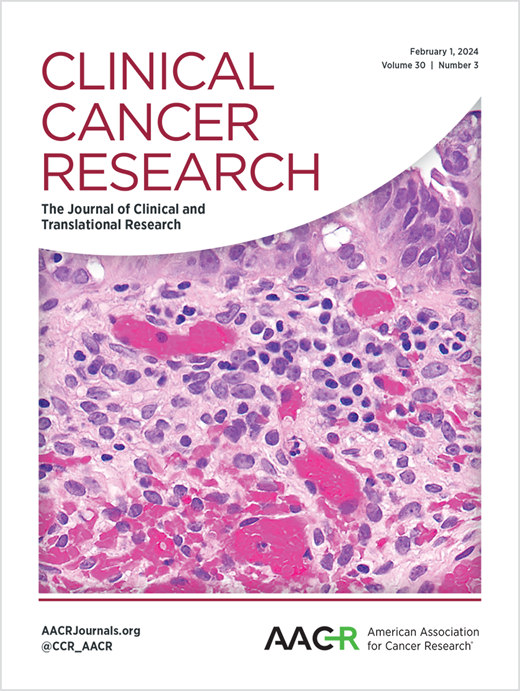癌症易感基因中的致病变异易导致乳腺导管原位癌
IF 10
1区 医学
Q1 ONCOLOGY
引用次数: 0
摘要
目的:确定癌症易感基因中的种系致病变体 (PV) 与导管原位癌 (DCIS) 风险之间的关系。方法:研究乳腺癌易感基因中的种系致病变异(PVs)频率:比较DCIS病例与未受影响的对照组之间,以及DCIS与浸润性导管癌(IDC)病例之间的种系乳腺癌易感基因(ATM、BARD1、BRCA1、BRCA2、CDH1、CHEK2、PALB2、RAD51C和RAD51D)的PV频率,这些基因来自临床检测队列(n=9887)、人口队列(n=3876)和英国生物库(n=2421)。在基于人群的队列中估算了有PV的DCIS病例罹患对侧乳腺癌的风险。结果显示在临床检测队列和基于人群的队列中,分别有 6.5% 和 4.6% 的 DCIS 妇女观察到了种系 PV。在 DCIS 妇女中,BRCA1、BRCA2 和 PALB2 的 PV 频率明显低于 IDC(临床队列:2.8% 对 5.7%;人群队列:1.7% 对 3.7%),而 ATM 和 CHEK2 的 PV 频率相似。在两个队列中,ATM、BRCA1、BRCA2、CHEK2 和 PALB2 PV 与 DCIS 风险增加显著相关(OR>2.0),但只有 BRCA2 PV 与高风险相关(OR>4)。在 15 年的时间里,高渗透性基因中的 PV 携带者患 DCIS 的对侧乳腺癌的累积发病率为 23%。结论在患有 DCIS 的妇女中,ATM、BRCA1、BRCA2、CHEK2 和 PALB2 中的 PVs 的富集表明,多基因小组检测可能适合患有 DCIS 的妇女。在患有 DCIS 的高穿透基因 PV 携带者中,患对侧乳腺癌的风险升高,这证实了检测对手术决策的作用。本文章由计算机程序翻译,如有差异,请以英文原文为准。
Pathogenic variants in cancer susceptibility genes predispose to Ductal Carcinoma In situ of the breast
Purpose: To determine the relationship between germline pathogenic variants (PVs) in cancer predisposition genes and the risk of ductal carcinoma in situ (DCIS). Methods: Germline PV frequencies in breast cancer predisposition genes (ATM, BARD1, BRCA1, BRCA2, CDH1, CHEK2, PALB2, RAD51C, and RAD51D) were compared between DCIS cases and unaffected controls, and between DCIS and infiltrating ductal carcinoma (IDC) cases from a clinical-testing cohort (n=9,887), a population-based cohort (n=3,876) and the UK Biobank (n=2421). The risk of contralateral breast cancer for DCIS cases with PVs was estimated in the population-based cohort. Results: Germline PVs were observed in 6.5% and 4.6% of women with DCIS in the clinical-testing and population-based cohorts, respectively. BRCA1, BRCA2, and PALB2 PVs frequencies were significantly lower among women with DCIS than IDC (clinical cohort: 2.8% vs. 5.7%; population-based cohort: 1.7% vs. 3.7%), whereas the PV frequencies for ATM and CHEK2 were similar. ATM, BRCA1, BRCA2, CHEK2, and PALB2 PVs were significantly associated with an increased risk of DCIS (OR>2.0), but only BRCA2 PVs were associated with high-risk (OR>4) in both cohorts. The cumulative incidence of contralateral breast cancer among carriers of PVs in high penetrance genes with DCIS was 23% over 15 years. Conclusions: The enrichment of PVs in ATM, BRCA1, BRCA2, CHEK2 and PALB2 among women with DCIS suggests that multigene panel testing may be appropriate for women with DCIS. Elevated risks of contralateral breast cancer in carriers of PVs in high penetrance genes with DCIS confirmed the utility of testing for surgical decision-making.
求助全文
通过发布文献求助,成功后即可免费获取论文全文。
去求助
来源期刊

Clinical Cancer Research
医学-肿瘤学
CiteScore
20.10
自引率
1.70%
发文量
1207
审稿时长
2.1 months
期刊介绍:
Clinical Cancer Research is a journal focusing on groundbreaking research in cancer, specifically in the areas where the laboratory and the clinic intersect. Our primary interest lies in clinical trials that investigate novel treatments, accompanied by research on pharmacology, molecular alterations, and biomarkers that can predict response or resistance to these treatments. Furthermore, we prioritize laboratory and animal studies that explore new drugs and targeted agents with the potential to advance to clinical trials. We also encourage research on targetable mechanisms of cancer development, progression, and metastasis.
 求助内容:
求助内容: 应助结果提醒方式:
应助结果提醒方式:


